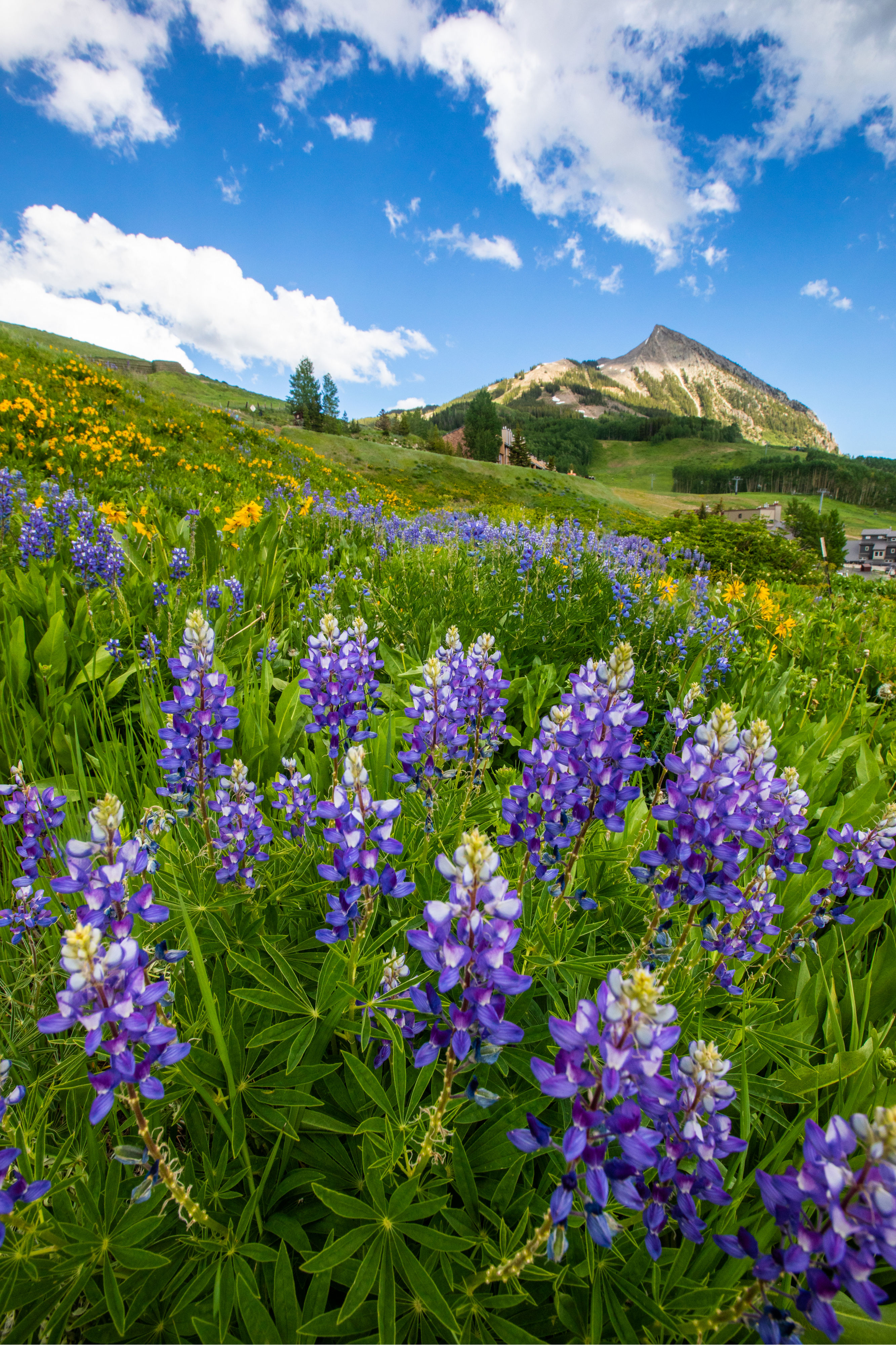
Lupine (Lupinus ssp.)
Lower Mountain Wildflowers
Whether you're poking around the base area or meandering down from the top of Red Lady Express, you’ll find a variety of flowers everywhere you look. At elevations below 11,500 ft., wildflowers start to bloom in late June and typically peak by the end of July. For pictures and more information about wildflowers on the lower mountain at Crested Butte, download the Wildflower Festival’s official subalpine wildflower guide.
1. Richardson’s Geranium (Geranium Richardsonii)
Richardson’s geranium flowers are long-stemmed with five small, round petals on top. The petals are either white or light pink. Look for lines on the petals, known as nectar lines. They’re generally found in clusters along the lower mountain and are often in abundance along the Up and Away trail.
2. Colorado Columbine (Aquilegia Coerulea)
These flowers are so common we have a trail named after them! Colorado columbine can grow over two feet tall. They feature upright blue and white flowers. The genus name "Aquilegia" comes from the Latin "aquila" which means "eagle" and refers to the spurred petals that many believe resemble an eagle's talons. This is the official flower of the state of Colorado.
3. Lupine (Lupinus ssp.)
Perhaps the most recognizable wildflower in the entire Gunnison Valley, lupine can grow up to three feet tall. The flowers feature columns of small, pea-like clusters that are blue or purple in color. Lupines love sunshine, so you’re sure to find plenty of these beauties in open areas. They’re especially abundant along the fittingly named Lupine trail near town!
4. Mountain Bluebells (Mertensia Ciliata var. Ciliata)
You can find mountain bluebells blanketing large meadows and hillsides and near moist areas such as creeks. Their leafy stems can grow up to three feet tall, and their hanging flowers give off a strong, sweet scent. They have blue-green foliage and sweet-scented blooms. You can watch the flowers change color as they age, beginning pink and eventually becoming blue.
5. Showy Goldeye (Heliomeris Multiflora)
These flowers are as golden as their name suggests. They are late-blooming members of the sunflower family, Showy goldeneye grow along open, dry slopes and roadsides. These flowers are smaller than their sunflower counterparts, but they grow in large groups, and their bright yellow color makes them easy to spot.
Alpine Area Wildflowers
Keep hiking or biking uphill and you’ll start to spot a whole new variety of flowers. Alpine wildflowers and shrubs are found above tree line, at approximately 11,500 feet in elevation, on Alpine meadows, ridges and peaks. They bloom from late June through early August. For pictures and more information about wildflowers on the upper mountain, download the Wildflower Festival’s official Alpine wildflower guide.
6. Sky Pilot (Polemonium Viscosum)
Sky pilot is also known as “sticky polemonium” because its leaves are – you guessed it – sticky! This wildflower thrives on dry and rocky south-facing slopes. The plants grow to be about seven inches tall. Its flowers are vivid shades of blue and purple and are known for their pungent odor.
7. Alpine Sunflower/Old Man of the Mountain (Hymenoxys Grandiflora)
This wildflower is as memorable as its name. Old man of the mountain got its nickname due to its appearance: a stout sunflower that’s covered with little hairs. They grow in higher elevations along rock faces. The bright yellow flower heads are known for being very large in comparison to the rest of the plant, making these guys difficult to miss on an Alpine hike or bike ride.
8. Mountain Sorrel (Oxyria Digyna)
A member of the buckwheat family, mountain sorrel is common on the upper mountain in Crested Butte. It grows in short, dense clusters and has a reddish-brown color. It prefers wet areas that are protected by snow in winter, which is why it is well suited for our high Alpine environment. The plant can be eaten raw or cooked and is also known as Oxyria, Greek for "sour," due to its acidic taste.
9. Spotted Saxifrage (Saxifraga bronchialis var. Austromontan)
These wildflowers are easy to spot because of their spots! Spotted saxifrage flowers have five white petals dotted with red, purple, yellow and orange spots. They live in rock crevices and along cliffs and grow close together, giving the plant a cushioned, moss-like appearance.
10. Alpine Phlox (Phlox Condensata)
These flowers may be tiny, but you won’t miss them! Alpine phlox, also called “dwarf phlox,” grow in very compact patches and prefer exposed, rocky spaces. They’re some of the sweetest-smelling Alpine flowers and, because they grow so close together, you can often smell them on a still day — even though they rarely get taller than one centimeter. Alpine phlox in Crested Butte are generally white, but they can also be found in shades of pink.
These are just a few of the hundreds of types wildflowers you may encounter when you visit Crested Butte for your summer adventures! Check them out for yourself or sign up for a workshop or guided hike during the Wildflower Festival to learn from the experts. You can also sign up for the Interpretive Wildflower Program at the Rocky Mountain Biological Laboratory nearby or pick up a copy of Reavis’ Wildflower Field Guide if you want a self-guided experience. Whichever way you choose to explore, please refrain from picking flowers in order to preserve the health and beauty of our natural landscape for generations to come.
